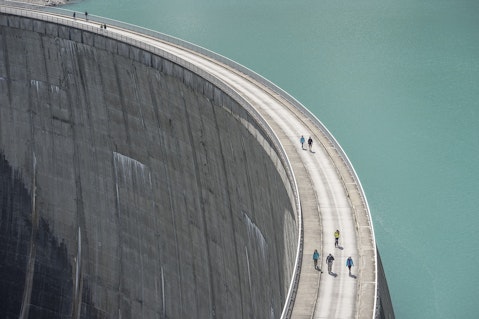In this article, we will be taking a look at the 15 countries that produce the most hydropower in the world. To skip our detailed analysis of this renewable energy, you can go directly to see 5 Countries That Produce The Most Hydropower.
Hydropower, also known as water power or hydroelectricity, is the use of falling or fast-running water to produce electricity or to power machines. This power, often found in streams and rivers that flow from hills and mountains, is a method of sustainable energy production as it converts the gravitational potential or kinetic energy of a water source to produce power. With almost a decade and a half of history behind it, innovation in this field has never stopped. Currently, there is a primary focus on increasing the flexibility of plants through changes in turbine design and operational patterns, and through digitalization. Hydropower’s contribution is 55% higher than nuclear power’s and larger than that of all other renewables combined, including wind, solar photovoltaic, bioenergy and geothermal. In 2020, hydropower supplied 17% of global electricity generation, the third‑largest source after coal and natural gas. Globally, around half of hydropower’s economically viable potential is untapped. This potential is particularly high in emerging economies and developing economies, reaching almost 60%. Following a research report, Rystad Energy analyst Karan Satwani commented that:
“Hydropower is the backbone of low-carbon electricity generation and has been rising since the 1970s. Over the last two decades, the installed global capacity of hydropower has grown from 680 GW in 2000 to nearly 1,200 GW in 2021, a surge of more than 75%.”
According a report by the IHA (International Hydropower Association), hydropower is set to solidify its position as the most popular renewable energy source, as global installed hydropower capacity increased by 1.9% to reach 1,360 GW at the end of 2021. In fact, hydropower is considered one of the cheapest sources of energy; after a facility’s construction and installation, harnessing the power of flowing water is theoretically free. Most of the capacity additions until 2030 are expected to come from large-scale projects in Asia and Africa. In Africa specifically, installed capacity is expected to grow at a combined annual growth rate of 2.5% from 2017 to 2023, driven by Ethiopia, Mozambique and Uganda. Predictably, countries with the highest share of hydropower consumption are those with plenty of running water.

Pixabay/Public domain
Our Methodology
To determine the top countries that produce the most hydropower, we consulted the International Hydropower Association’s 2022 Hydropower Status Report. IHA publishes an annual report that provides an overview of hydropower trends in the global energy system that is based on a comprehensive review of hydropower data from countries and territories across the globe.
We scoured through the IHA’s annual report and studied the installed hydropower capacity section of the report. We sorted the section by hydropower capacity in 2021, in ascending order, and picked the top 15 names. We have ranked these countries in ascending order of their hydropower capacities, which are measured in gigawatts (GW).
Countries That Produce The Most Hydropower
15. Sweden
Installed Hydropower Capacity: 16.5 GW
Hydropower, alongside nuclear power, is the foundation of the Swedish electricity system. Operating as one of the main sources of renewable energy in the country, hydropower accounts for around 45% of Sweden’s total electricity production. With an economy that is growing at about 5% annually, one of the highest rates in Europe, Sweden produces some 63.9 TWh/year to meet the country’s demand for electrical energy. Overall, the country’s resources are primarily located in the northern and central regions, which have a high potential for hydropower due to the presence of many rivers and lakes. The Harsprånget is the largest hydro power plant in Sweden in terms of capacity, as well as the site of the country’s largest single hydro power unit, the 450 MW ‘Gigantic Gerhard’.
14. Switzerland
Installed Hydropower Capacity: 16.8 GW
Hydropower is a cornerstone of the Swiss energy policy. In 2021, the country generated 61.5% of its electricity from hydropower, while 28.9% was generated from nuclear energy, 1.9% from fossil fuels and 7.7% from other renewable sources. Due to its topography and high levels of annual rainfall, Switzerland has ideal conditions for the use of hydropower. There are roughly 682 hydropower plants in Switzerland that each have a capacity of at least 300 kilowatts, producing an average of around 37,172 GWh/y, 48.3 % of which is produced in run-of-river power plants, 47.5 % in storage power plants and approximately 4.2 % in pumped storage power plants. Between the months of May and October, Switzerland typically produces enough electricity via nuclear and hydroelectric power stations to cover national demand alongside exports of nearly 30 billion kWh.
13. Vietnam
Installed Hydropower Capacity: 17.3 GW
With an installed capacity of 17.3 GW, hydropower currently contributes some 33% of Vietnam’s total power generation. Owing to an annual hydropower potential of 120,000 GWh, Vietnam is one of the most vital and prospective hydropower markets.
12. Spain
Installed Hydropower Capacity: 20.4 GW
Although not as significant as other forms of renewable energy such as wind, Spain has a moderate hydropower capacity, accounting for about 11.4% of the country’s total electricity production in 2021, making it the fourth-most important energy source after wind power, nuclear energy and natural gas-fueled combined cycle power plants. During the period of 2009 to 2022, hydropower generation in the country experienced fluctuations, although it reached a peaked in 2014 with a generation of approximately 39.2 terawatt-hours. Most of the installed hydropower base in Spain is conventional hydropower with some 3,329 MW of pumped storage within this total. This plays a major role in balancing the intermittent resources of renewable electricity generation as it helps stabilize the grid and provide peak power load. Due to this, there are a number of pumped storage hydropower projects in the planning and permission phase throughout the country.
11. Italy
Installed Hydropower Capacity: 22.6 GW
With a history that has its roots in the late 1800s, hydropower is Italy’s oldest source of renewable energy. Although solar and wind power might become the two main candidates driving forward Italy’s green future, hydropower still accounts for more than a third of the country’s renewable energy scene. Numbering around 4400 in total, the majority of the country’s installed hydropower capacity is located in the northern regions of Lombardy, Trentino-Alto Adige/Südtirol, and Valle d’Aosta. Italy’s largest hydropower plant is located in Piedmont, in the Province of Cuneo, at Entracque. In 2030, the quantity of hydroelectricity produced in Italy is forecast to reach 50,130 GWh.
10. France
Installed Hydropower Capacity: 25.7 GW
On account of its large share of hydropower and nuclear energy, France has achieved an absolute decoupling of its greenhouse gas emissions from GDP growth since 2005, as emissions have either held steady or reduced as the economy has grown. The third largest European producer of hydroelectricity behind only Norway and Turkey, France continues to make up over half of its renewable energy supply through hydropower. Back in 2021, France produced around 59 TWh of primary renewable hydroelectric energy, while in previous years, the country’s hydroelectricity production fluctuated between 50 and 70 TWh, approximately.
9. Turkey
Installed Hydropower Capacity: 31.5 GW
Due to a combination of abundant resources, a supportive government, and favorable policy framework, Turkey remains one of Europe’s leading markets for future hydropower development. Over 700 hydropower plants have been built, and hydroelectricity makes up about 30% of the country’s electricity generating capacity.
8. Norway
Installed Hydropower Capacity: 33.4 GW
Known for its high mountain plateaus, abundant natural lakes and steep valleys and fjords, Norway’s topography lends itself perfectly to hydropower development. Hydropower operated as the foundation for the nation’s industrialization in the late 19th century, and remains the backbone of its power system. Norway uses hydropower for around 90% of its electricity output and the country relies on having well-filled reservoirs for the peak-demand winter months.
7. Japan
Installed Hydropower Capacity: 49.6 GW
Representing one of the largest consumers of hydropower worldwide, Japan is considered to be almost fully developed in terms of conventional hydropower potential , with little opportunity for further capacity increase. Since the country has constructed large-scale hydroelectric facilities at nearly all potential sites, typically at large dams, a further increase in the generation capacity is hardly possible. Therefore, recent constructions have been on a smaller scale, mostly developing pumped-storage plants. In 2021, the hydropower generation capacity in Japan stood at around 50 GW and these figures have remained at around the same level in recent years.
6. India
Installed Hydropower Capacity: 51.4 GW
India ranks 6th globally in terms of installed hydroelectric power capacity. The hydropower capacity in India is expected to reach 70 GW by 2030, according to the Ministry of New and Renewable Energy (MNRE). At the end of 2021, the South Asian country’s total hydropower capacity stood at over 51.4 GW—including 45.4 GW of large hydropower capacity (above 10 MW)—and more than 12 GW are currently under construction.
Click to continue reading and see 5 Countries That Produce The Most Hydropower.
Suggested articles:
- 15 Most Innovative Countries in the World
- 15 Most Valuable Silicon Valley Companies in the World
- 25 Highest Paid Athletes of All Time
Disclosure: None. 15 Countries That Produce The Most Hydropower is originally published on Insider Monkey.





